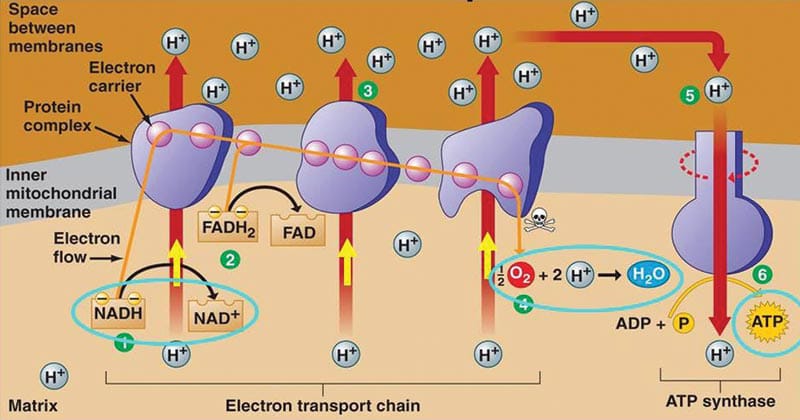MCQ ON ELECTRON AND TRANSPORT SYSTEM AND OXIDATIVE PHOSPHORYLATION class 11 for NEET | ELECTRON TRANSPORT SYSTEM AND OXIDATIVE PHOSPHORYLATION class 11 | MCQ ELECTRON TRANSPORT SYSTEM AND OXIDATIVE PHOSPHORYLATION with Answer | Check the below NCERT MCQ question for class 11 Biology based on the with Answers.

MCQ ON ELECTRON AND TRANSPORT SYSTEM AND OXIDATIVE PHOSPHORYLATION class 11 for NEET
MCQ on ELECTRON TRANSPORT SYSTEM AND OXIDATIVE PHOSPHORYLATION class 11 Biology with answers were prepared based on the latest pattern.We have provided class 11 Biology MCQs question with Answers to help students understand the concept very well.
MCQ ON ELECTRON TRANSPORT SYSTEM AND OXIDATIVE PHOSPHORYLATION is useful for NEET / CSIR / UGC / CBSE / ICSE / AIIMS / EXAM / AFMC EXAM / STATE LEVEL MEDICAL EXAM/ KVS PGT BIOLOGY / NVS PGT BIOLOGY EXAM 2022-23 , 2023-24
INTRODUCTION:-
The metabolic pathways through which the electron passes from one carrier to another, is called the electron transport system and it is present in the inner mitochondrial membrane.
Electron from NADH produced in the mitochondrial matrix during Citric acid cycle are oxidised by an NADH dehydrogenase (complex I), and then electron are transferred to ubiquinone located within the inner membrane.
Ubiquinone also receives reducing equivalents via FADH2 (complex II) that is generated during oxidation of succinate in the Citric acid cycle .
The reduced ubiquinone is then oxidised with the transfer of electron to cytochrome c via cytochrome bc1 complex ( complex III) .
Cytochrome c is a small protein attached to the outer surface of the inner membrane and acts as a mobile carrier for transfer of electron between complex III and IV.
Complex IV refers to cytochromes c oxidase complex containing cytochromes a and a3 and two copper centre.
When the electrons pass from one carrier to another via complex I to IVin the electron transport chain, they are couple to ATP synthase ( complex V) for the production of ATP from ADP and inorganic phosphate.
MCQ ON ELECTRON TRANSPORT SYSTEM AND OXIDATIVE PHOSPHORYLATION class 12 for NEET/KVS PGT BIOLOGY / NVS PGT BIOLOGY
1. The final hydrogen acceptor is
(a) NADH
(b) Oxygen
(c) FADH2
(d) ATP
Ans (b) oxygen
2. FAD acts as an electron acceptor is between
(a) fumaric acid and malic acid
(b) succinic acid and fumaric acid
(c) malic acid and oxaloacetic acid
(d) citric acid and isocitric acid
Ans. (b) succinic acid and fumaric acid
3. Which of the following is the key intermediate compound linking Glycolysis to the Krebs cycle?
(a) NADH
(b) ATP
(c) Acetyl CoA
(d) malic acid
Ans. (c) Acetyl CoA
4. In which types of the reaction related to plant photosynthesis peroxisomes are involved.
(a) Glycolate cycle
(b) Calvin cycle
(c) Bacterial photosynthesis
(d) Glyoxylate cycle
Ans.(d) Glyoxylate cycle
5.Pyruvate dehydrogenase complex , needed for the conversion of Pyruvic acid to Acetyl CoA is located in
(a) grana of chloroplast
(b) cytoplasm
(c) matrix of mitochondria
(d) intermembrane space of mitochondria
Ans.(c) matrix of mitochondria
6.The end product of oxidative phosphorylation is
(a) NADH
(b) oxygen
(c) ADP
(d) ATP
Ans.(a) NADH
7. Which of the following exhibit the highest rate of respiration ?
(a) Growing shoot apex
(b) Germinating seed
(c) Root tip
(d) Leaf bud
Ans.(b) Germinating seed
8. Electron transport system is located in mitochondrial
(a) outer membrane
(b) inner membrane space
(c) inner membrane
(d) matrix
Ans.(b) inner membrane space
9. Most enzymes that take part in ‘Krebs cycle ‘are located in
(a) mitochondria matrix
(b) cytoplasm
(c) inner mitochondrial membrane
(d) plasma membrane
Ans. (a) mitochondria matrix
10. The overall goal of glycolysis, Krebs cycle and electron transport system is the formation of
(a) ATP in one large oxidation reaction
(b) sugars
(c) nucleic acids
(d) ATP in small stepwise units
Ans. (d) ATP in small stepwise units
11. The number of glucose molecules required to produce 38 ATP molecules under an anerobic condition by yeast cell is
(a) 2
(b) 4
(c) 19
(d) 24
Ans.(c) 19
12.There is V complex
(a) cytochromes b
(b) cytochromes c
(c) cytochromes a
(d) ATP synthase
Ans . (d) ATP synthase
13. Complex I in electron transport system is
(a) NADH dehydrogenase complex
(b) FADH2 complex
(c) cytochromes oxidase complex
(d) succinate dehydrogenase complex
Ans.(a) NADH dehydrogenase complex
14. Complex III in electron transport system is
(a) NADH
(b) FADH2
(c) Cytochromes bc1
(d) all the above
Ans. (c) Cytochromes bc1
15. Complex IV in the electron transport system is
(a) cytochromes oxidase complex
(b) cytochromes bc1
(c) cytochromes c3
(d) NADH
Ans.(a) cytochromes oxidase complex
ALSO READ:-
● YOU CAN WATCH BIOLOGY SIR Youtube channel
16. ATP synthesis in ATP ase complex protein is present in
(a) inner membrane of the mitochondria
(b) matrix of the mitochondria
(c) cytoplasm
(d) nucleus
Ans.(a) inner membrane of mitochondria







Leave a Comment